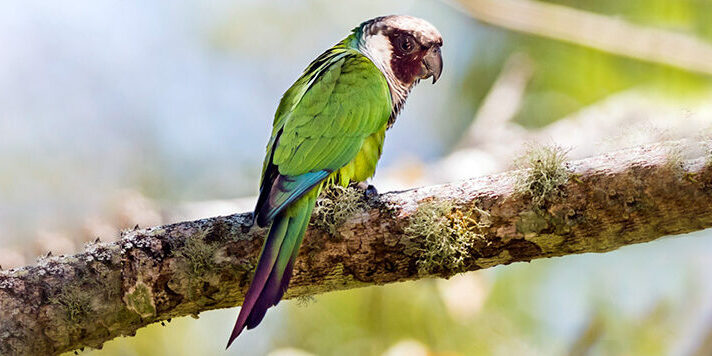Bird of The Week: Gray-breasted Parakeet
Scientific Name: Pyrrhura griseipectus
Population: ~1000
IUCN Status: Endangered
Trend: Increasing
Habitat: Humid mountain forest in Northeast Brazil
About
The Gray-breasted Parakeet is a rainbow of colors, its bright-green plumage punctuated by a reddish belly, rump, tail, and shoulders; a light gray, scaly breast; and white ear patches. Add a maroon face, some bluish highlights, and a spotted gray cap, and suddenly the common name Gray-breasted seems not to aptly represent this pretty species. (Or does it? Read on to find out why the name is useful.)
Found only in a few small areas in northeastern Brazil, this species faced decades of deforestation and decline. It is listed as Endangered on the IUCN Red List, along with 16 other “New World” species including the Santa Marta Parakeet and El Oro Parakeet.
An Outlier No More
The Gray-breasted Parakeet was once considered an isolated subspecies of the Maroon-faced Parakeet of eastern Brazil. One visual distinction was the pale gray breast in this “outlier” population. Recent advances in genetic analysis resulted in the splitting of this species, and also the Goiás (also known as the Pfrimer’s) Parakeet, from the Maroon-faced.
All three of these Brazilian parakeet species have distinctive appearances, habitats, and completely separate ranges.
Songs and Sounds
The Gray-breasted Parakeet’s calls are a high-pitched, rapid series of notes described as chee-cheet. It also gives short, single notes while perched.
Breeding and Feeding
Like many other parrots, including the Red-masked Parakeet and the Great Green Macaw, the Gray-breasted Parakeet feeds quietly on fruit and seeds high in the tree canopy, often unnoticed by passersby.
Family Ties
This parakeet is a social species that lives in family groups of four to 15 individuals. It breeds once a year, from February until June.
Unable to excavate her own nest hole, the female Gray-breasted Parakeet usually repurposes an old tree cavity dug by a woodpecker for a nest site. She may also choose a human-made nest box or even a rock crevice. The latter, rather unusual type of nest site is also used by the Goiás Parakeet. The female Gray-breasted Parakeet lays an average of six eggs. After incubation takes place, both male and female feed the nestlings, sometimes assisted by other members of their family group. The family group will sleep together throughout the year in the same cavity.
Range
The Gray-breasted Parakeet is found only in humid, high-elevation forests in otherwise semi-arid northeastern Brazil. These wetter “sky islands,” known locally as brejos, are restricted to upland granite or sandstone areas, which receive up to four times the annual rainfall of lower altitudes.
Although this parakeet was once known from 15 locations, now it can only be found in a few areas of Brazil’s Ceará state.
Conservation
Stopping a Species’ Slide
Habitat loss is the biggest threat to this species. Barely 13 percent of the Gray-breasted Parakeet’s original habitat remains. Until recently, most of the population was found in just one isolated area.
Trapping for the cage bird trade, which threatens other Brazilian endemics such as the Banded Cotinga, is another factor in the Gray-breasted Parakeet’s decline.
ABC and partner Aquasis have been working in the Baturité Mountains, one of the species’ last wild strongholds, to prevent the Gray-breasted Parakeet’s extinction. Aquasis has collaborated with landowners to prevent poaching and to install nest boxes that provide the parakeets with nesting sites. The nest box program has been successful, adding hundreds of birds to the population — enough to get the species downlisted from Critically Endangered to Endangered in 2017.
In addition, the partners have begun to establish additional populations of the species. For the first attempted reintroduction, they selected a protected area in the Aratanha Mountains, about 35 miles northeast of the Baturité Mountains. Starting in November 2021, conservationists took several groups of Gray-breasted Parakeets to the new site. In February 2023, three chicks fledged at the reintroduction site — the first official members of the first-ever reintroduced population of Gray-breasted Parakeets.
Get Involved
Many of the rarest bird species in the Western Hemisphere remain relatively unknown. You can learn more about these birds and the threats they face by signing up for ABC’s Bird of the Week email series, which frequently highlights these fascinating birds.
American Bird Conservancy and our partners throughout Latin America and the Caribbean have created and expanded more than 100 bird reserves, which protect upward of 1.1 million acres of vital habitat. Together, we’ve planted more than 6.8 million trees, helping to restore degraded and damaged habitat. You can help us continue to protect endangered birds by making a gift today.
Source: American Bird Conservancy (abcbirds.org)


